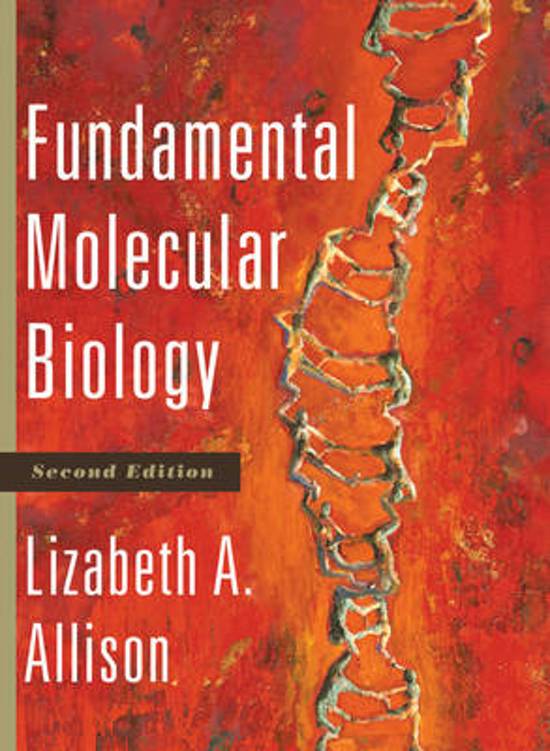
- ISBN
- Auteur(s)
- Langue
- Éditeur
- Édition
- Édition
Fundamental Molecular Biology résumés
Lizabeth Allison - ISBN: 9781118059814
- ISBN
- Auteur(s)
- Langue
- Éditeur
- Édition
- Édition
Afficher tous les 11 résumés de Fundamental Molecular Biology, écrits par Lizabeth Allison. Les résumés de Fundamental Molecular Biology sur Stuvia sont écrits par des étudiants ou des enseignants, ce qui facilite et accélère la compréhension du contenu du manuel. Trouver le résumé qui correspond parfaitement à votre style d'apprentissage rendra l'étude beaucoup plus facile.
Résumés les plus vendus pour Fundamental Molecular Biology
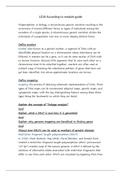
a. Define marker b. Define mapping c. Explain the concept of “linkage analysis” d. Explain what a RFLP is and how it is generated e. Differentiate between physical maps, cytogenetic maps and linkage f. Explain why genome mapping are beneficial in finding genes g. Discuss how RFLPs can be used as markers of genetic diseases h. Discuss PCR-RFLP i. Explain what DNA typing is and what it is used for j. Define polymorphism k. Compare and contrast the following DNA markers: STRs, SNPs, Minis...
- Study guide
- • 9 pages •
a. Define marker b. Define mapping c. Explain the concept of “linkage analysis” d. Explain what a RFLP is and how it is generated e. Differentiate between physical maps, cytogenetic maps and linkage f. Explain why genome mapping are beneficial in finding genes g. Discuss how RFLPs can be used as markers of genetic diseases h. Discuss PCR-RFLP i. Explain what DNA typing is and what it is used for j. Define polymorphism k. Compare and contrast the following DNA markers: STRs, SNPs, Minis...
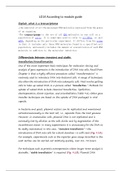
a. Explain what is a transcriptome b. Differentiate between transient and stable transfection/transformation c. Differentiate between constitutive expression, spatial expression and temporal expression d. Explain what a microarray is e. Explain how a microarray can be used to detect differences in gene expression
- Study guide
- • 7 pages •
a. Explain what is a transcriptome b. Differentiate between transient and stable transfection/transformation c. Differentiate between constitutive expression, spatial expression and temporal expression d. Explain what a microarray is e. Explain how a microarray can be used to detect differences in gene expression
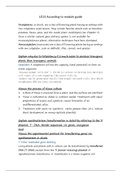
a. Explain why due to totipotency it is much easier to produce transgenic plants than transgenic animals b. Discuss the process of tissue culture c. List and discuss the major strategies for gene transfer to plant cells i. Explain agrobacterium transformation in detail by referring to the Ti plasmid, T- DNA, border sequences, vir genes, oncogenes ii. Discuss the experimental protocol for transferring genes via agrobacterium in dicots 2. Discuss electroporation and microballistics (gene gun) as...
- Study guide
- • 3 pages •
a. Explain why due to totipotency it is much easier to produce transgenic plants than transgenic animals b. Discuss the process of tissue culture c. List and discuss the major strategies for gene transfer to plant cells i. Explain agrobacterium transformation in detail by referring to the Ti plasmid, T- DNA, border sequences, vir genes, oncogenes ii. Discuss the experimental protocol for transferring genes via agrobacterium in dicots 2. Discuss electroporation and microballistics (gene gun) as...
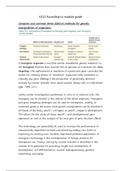
a. Compare and contrast three distinct methods for genetic manipulation of organisms b. Discuss step by step how to make a transgenic mouse c. Explain how transgene expression can be analysed d. What is meant by “inducible transgenic mice”? e. What is “knockout mouse” f. Discuss the role of model organisms in Molecular biology studies i. Consider the characteristics of a model organism as well.
- Study guide
- • 7 pages •
a. Compare and contrast three distinct methods for genetic manipulation of organisms b. Discuss step by step how to make a transgenic mouse c. Explain how transgene expression can be analysed d. What is meant by “inducible transgenic mice”? e. What is “knockout mouse” f. Discuss the role of model organisms in Molecular biology studies i. Consider the characteristics of a model organism as well.
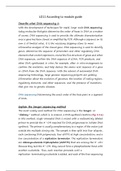
a. Describe what DNA sequencing is b. Explain the Sanger sequencing method i. In your answer refer to the primer, type of nucleotides and polymerase c. Read a DNA sequence from an autoradiograph d. Explain how DNA sequencing can be automated by replacing radioactive labels with fluorescent labels e. Explain the use of next-generation sequencing f. Explain the principle of “sequence-by-synthesis”
- Study guide
- • 4 pages •
a. Describe what DNA sequencing is b. Explain the Sanger sequencing method i. In your answer refer to the primer, type of nucleotides and polymerase c. Read a DNA sequence from an autoradiograph d. Explain how DNA sequencing can be automated by replacing radioactive labels with fluorescent labels e. Explain the use of next-generation sequencing f. Explain the principle of “sequence-by-synthesis”
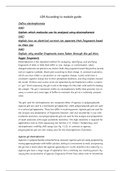
a. Define electrophoresis b. Explain which molecules can be analysed using electrophoresis c. Explain how an electrical current can separate DNA fragments based on their size d. Explain why smaller fragments move faster through the gel then bigger fragments e. Determine the size of unknown DNA fragments by using a DNA ladder f. Construct a restriction map based on sizes of fragments g. Explain the role of positive and negative controls in an experiment h. Explain the function of a loading d...
- Study guide
- • 8 pages •
a. Define electrophoresis b. Explain which molecules can be analysed using electrophoresis c. Explain how an electrical current can separate DNA fragments based on their size d. Explain why smaller fragments move faster through the gel then bigger fragments e. Determine the size of unknown DNA fragments by using a DNA ladder f. Construct a restriction map based on sizes of fragments g. Explain the role of positive and negative controls in an experiment h. Explain the function of a loading d...
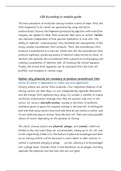
a. Explain why plasmids are necessary to produce recombinant DNA b. Explain the difference between chromosomal DNA and plasmid DNA within E.Coli. c. Describe the three different conformations in which plasmid DNA is found d. Describe how these different conformations will separate on an agarose gel during electrophoreses e. Explain how plasmid DNA is purified from E.coli cells by using the alkaline lysis approach. In your answer refer to the function of each reagent f. Explain why the above-me...
- Study guide
- • 8 pages •
a. Explain why plasmids are necessary to produce recombinant DNA b. Explain the difference between chromosomal DNA and plasmid DNA within E.Coli. c. Describe the three different conformations in which plasmid DNA is found d. Describe how these different conformations will separate on an agarose gel during electrophoreses e. Explain how plasmid DNA is purified from E.coli cells by using the alkaline lysis approach. In your answer refer to the function of each reagent f. Explain why the above-me...
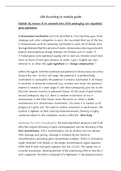
a. Explain the role of DNA packaging in gene expression regulation b. Explain by means of an example how DNA packaging can regulated gene expression c. Describe the role of transcription factors, enhancers, silencers and promoters in transcriptional regulation d. Explain how DNA-binding proteins can interact at a distance e. Explain why not all gene regulation targets transcription initiation f. Explain how alternative splicing give rise to different mRNA thus assisting with gene regulation ...
- Study guide
- • 14 pages •
a. Explain the role of DNA packaging in gene expression regulation b. Explain by means of an example how DNA packaging can regulated gene expression c. Describe the role of transcription factors, enhancers, silencers and promoters in transcriptional regulation d. Explain how DNA-binding proteins can interact at a distance e. Explain why not all gene regulation targets transcription initiation f. Explain how alternative splicing give rise to different mRNA thus assisting with gene regulation ...
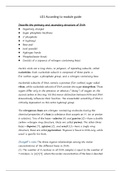
Describe the structure of DNA. a. Describe the primary and secondary structure of DNA b. Discuss alternative double-helical structures c. Discuss denaturation, melting temperature and renaturation d. Describe the tertiary structure of DNA by referring to supercoiling 2. Explain the structure of a chromosome a. Explain the processes involved in the packaging of DNA b. Discuss the role of packaging in a cell 3. Explain how nucleosomes affect nuclear processes to control gene expression 4. De...
- Study guide
- • 20 pages •
Describe the structure of DNA. a. Describe the primary and secondary structure of DNA b. Discuss alternative double-helical structures c. Discuss denaturation, melting temperature and renaturation d. Describe the tertiary structure of DNA by referring to supercoiling 2. Explain the structure of a chromosome a. Explain the processes involved in the packaging of DNA b. Discuss the role of packaging in a cell 3. Explain how nucleosomes affect nuclear processes to control gene expression 4. De...
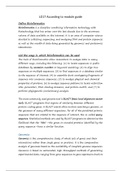
1. Define Bioinformatics 2. List the ways in which bioinformatics can be used 3. Discuss Blast results 4. List the various databases for nucleotide and protein sequences
- Resume
- • 3 pages •
1. Define Bioinformatics 2. List the ways in which bioinformatics can be used 3. Discuss Blast results 4. List the various databases for nucleotide and protein sequences
Avez-vous des documents qui correspondent à ce livre ? Vendez-les et gagnez de l'argent avec vos connaissances !
Derniers résumés de Fundamental Molecular Biology

a. Define marker b. Define mapping c. Explain the concept of “linkage analysis” d. Explain what a RFLP is and how it is generated e. Differentiate between physical maps, cytogenetic maps and linkage f. Explain why genome mapping are beneficial in finding genes g. Discuss how RFLPs can be used as markers of genetic diseases h. Discuss PCR-RFLP i. Explain what DNA typing is and what it is used for j. Define polymorphism k. Compare and contrast the following DNA markers: STRs, SNPs, Minis...
- Study guide
- • 9 pages •
a. Define marker b. Define mapping c. Explain the concept of “linkage analysis” d. Explain what a RFLP is and how it is generated e. Differentiate between physical maps, cytogenetic maps and linkage f. Explain why genome mapping are beneficial in finding genes g. Discuss how RFLPs can be used as markers of genetic diseases h. Discuss PCR-RFLP i. Explain what DNA typing is and what it is used for j. Define polymorphism k. Compare and contrast the following DNA markers: STRs, SNPs, Minis...

a. Explain what is a transcriptome b. Differentiate between transient and stable transfection/transformation c. Differentiate between constitutive expression, spatial expression and temporal expression d. Explain what a microarray is e. Explain how a microarray can be used to detect differences in gene expression
- Study guide
- • 7 pages •
a. Explain what is a transcriptome b. Differentiate between transient and stable transfection/transformation c. Differentiate between constitutive expression, spatial expression and temporal expression d. Explain what a microarray is e. Explain how a microarray can be used to detect differences in gene expression

a. Explain why due to totipotency it is much easier to produce transgenic plants than transgenic animals b. Discuss the process of tissue culture c. List and discuss the major strategies for gene transfer to plant cells i. Explain agrobacterium transformation in detail by referring to the Ti plasmid, T- DNA, border sequences, vir genes, oncogenes ii. Discuss the experimental protocol for transferring genes via agrobacterium in dicots 2. Discuss electroporation and microballistics (gene gun) as...
- Study guide
- • 3 pages •
a. Explain why due to totipotency it is much easier to produce transgenic plants than transgenic animals b. Discuss the process of tissue culture c. List and discuss the major strategies for gene transfer to plant cells i. Explain agrobacterium transformation in detail by referring to the Ti plasmid, T- DNA, border sequences, vir genes, oncogenes ii. Discuss the experimental protocol for transferring genes via agrobacterium in dicots 2. Discuss electroporation and microballistics (gene gun) as...

a. Compare and contrast three distinct methods for genetic manipulation of organisms b. Discuss step by step how to make a transgenic mouse c. Explain how transgene expression can be analysed d. What is meant by “inducible transgenic mice”? e. What is “knockout mouse” f. Discuss the role of model organisms in Molecular biology studies i. Consider the characteristics of a model organism as well.
- Study guide
- • 7 pages •
a. Compare and contrast three distinct methods for genetic manipulation of organisms b. Discuss step by step how to make a transgenic mouse c. Explain how transgene expression can be analysed d. What is meant by “inducible transgenic mice”? e. What is “knockout mouse” f. Discuss the role of model organisms in Molecular biology studies i. Consider the characteristics of a model organism as well.

a. Describe what DNA sequencing is b. Explain the Sanger sequencing method i. In your answer refer to the primer, type of nucleotides and polymerase c. Read a DNA sequence from an autoradiograph d. Explain how DNA sequencing can be automated by replacing radioactive labels with fluorescent labels e. Explain the use of next-generation sequencing f. Explain the principle of “sequence-by-synthesis”
- Study guide
- • 4 pages •
a. Describe what DNA sequencing is b. Explain the Sanger sequencing method i. In your answer refer to the primer, type of nucleotides and polymerase c. Read a DNA sequence from an autoradiograph d. Explain how DNA sequencing can be automated by replacing radioactive labels with fluorescent labels e. Explain the use of next-generation sequencing f. Explain the principle of “sequence-by-synthesis”

a. Define electrophoresis b. Explain which molecules can be analysed using electrophoresis c. Explain how an electrical current can separate DNA fragments based on their size d. Explain why smaller fragments move faster through the gel then bigger fragments e. Determine the size of unknown DNA fragments by using a DNA ladder f. Construct a restriction map based on sizes of fragments g. Explain the role of positive and negative controls in an experiment h. Explain the function of a loading d...
- Study guide
- • 8 pages •
a. Define electrophoresis b. Explain which molecules can be analysed using electrophoresis c. Explain how an electrical current can separate DNA fragments based on their size d. Explain why smaller fragments move faster through the gel then bigger fragments e. Determine the size of unknown DNA fragments by using a DNA ladder f. Construct a restriction map based on sizes of fragments g. Explain the role of positive and negative controls in an experiment h. Explain the function of a loading d...

a. Explain why plasmids are necessary to produce recombinant DNA b. Explain the difference between chromosomal DNA and plasmid DNA within E.Coli. c. Describe the three different conformations in which plasmid DNA is found d. Describe how these different conformations will separate on an agarose gel during electrophoreses e. Explain how plasmid DNA is purified from E.coli cells by using the alkaline lysis approach. In your answer refer to the function of each reagent f. Explain why the above-me...
- Study guide
- • 8 pages •
a. Explain why plasmids are necessary to produce recombinant DNA b. Explain the difference between chromosomal DNA and plasmid DNA within E.Coli. c. Describe the three different conformations in which plasmid DNA is found d. Describe how these different conformations will separate on an agarose gel during electrophoreses e. Explain how plasmid DNA is purified from E.coli cells by using the alkaline lysis approach. In your answer refer to the function of each reagent f. Explain why the above-me...

a. Explain the role of DNA packaging in gene expression regulation b. Explain by means of an example how DNA packaging can regulated gene expression c. Describe the role of transcription factors, enhancers, silencers and promoters in transcriptional regulation d. Explain how DNA-binding proteins can interact at a distance e. Explain why not all gene regulation targets transcription initiation f. Explain how alternative splicing give rise to different mRNA thus assisting with gene regulation ...
- Study guide
- • 14 pages •
a. Explain the role of DNA packaging in gene expression regulation b. Explain by means of an example how DNA packaging can regulated gene expression c. Describe the role of transcription factors, enhancers, silencers and promoters in transcriptional regulation d. Explain how DNA-binding proteins can interact at a distance e. Explain why not all gene regulation targets transcription initiation f. Explain how alternative splicing give rise to different mRNA thus assisting with gene regulation ...
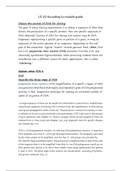
Discuss the sources of DNA for cloning 2. Explain the theoretical principles of PCR and the use of this technique in recombinant genetic technology & biotechnology a. Explain what PCR is b. Explain the role of primers, dNTPs, Taq polymerase and buffer in the reaction c. Describe the three steps of PCR d. Draw the first 3 cycles of PCR
- Study guide
- • 11 pages •
Discuss the sources of DNA for cloning 2. Explain the theoretical principles of PCR and the use of this technique in recombinant genetic technology & biotechnology a. Explain what PCR is b. Explain the role of primers, dNTPs, Taq polymerase and buffer in the reaction c. Describe the three steps of PCR d. Draw the first 3 cycles of PCR

Describe the structure of DNA. a. Describe the primary and secondary structure of DNA b. Discuss alternative double-helical structures c. Discuss denaturation, melting temperature and renaturation d. Describe the tertiary structure of DNA by referring to supercoiling 2. Explain the structure of a chromosome a. Explain the processes involved in the packaging of DNA b. Discuss the role of packaging in a cell 3. Explain how nucleosomes affect nuclear processes to control gene expression 4. De...
- Study guide
- • 20 pages •
Describe the structure of DNA. a. Describe the primary and secondary structure of DNA b. Discuss alternative double-helical structures c. Discuss denaturation, melting temperature and renaturation d. Describe the tertiary structure of DNA by referring to supercoiling 2. Explain the structure of a chromosome a. Explain the processes involved in the packaging of DNA b. Discuss the role of packaging in a cell 3. Explain how nucleosomes affect nuclear processes to control gene expression 4. De...
Avez-vous des documents qui correspondent à ce livre ? Vendez-les et gagnez de l'argent avec vos connaissances !
Pourquoi étudier avec les résumés de livres sur Stuvia ?

Pertinence, efficacité et commodité. Ce sont des éléments importants lors de l'étude ou de la préparation d'un cours ou d'un examen. Étudier à l'aide de résumés de livres, qui sont liés au numéro ISBN de votre livre (d'étude), est plus pertinent que jamais. Vos camarades étudiants ou tuteurs partagent leurs connaissances avec vous pour vous aider à préparer vos examens. Trouvez le numéro ISBN de votre livre et vous serez sûr d'acheter le bon résumé. Ainsi, vous n'aurez pas de surprises lors de vos examens.

Tous les résumés sur Stuvia sont rédigés par des étudiants qui ont déjà passé l'examen, des professeurs qui enseignent le matériel d'étude ou des éditeurs professionnels. En conséquence, vous pouvez être sûr que vous comprendrez plus facilement le matériel du cours et que le résumé contient tous les éléments testés dans l'examen. Trouvez le livre dont vous avez besoin pour étudier par son ISBN et choisissez le meilleur résumé de manuel.
